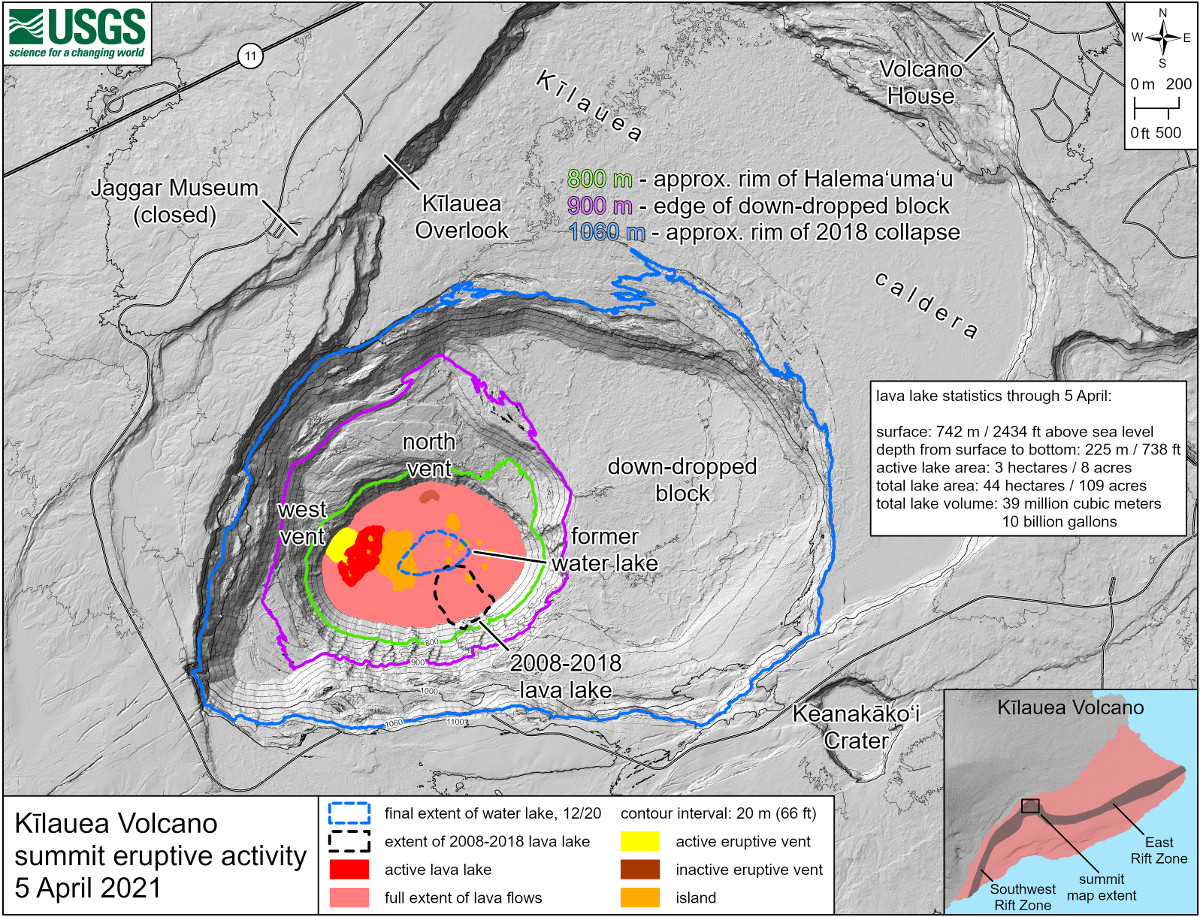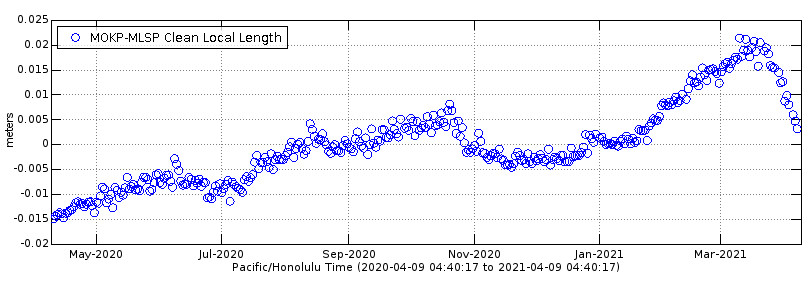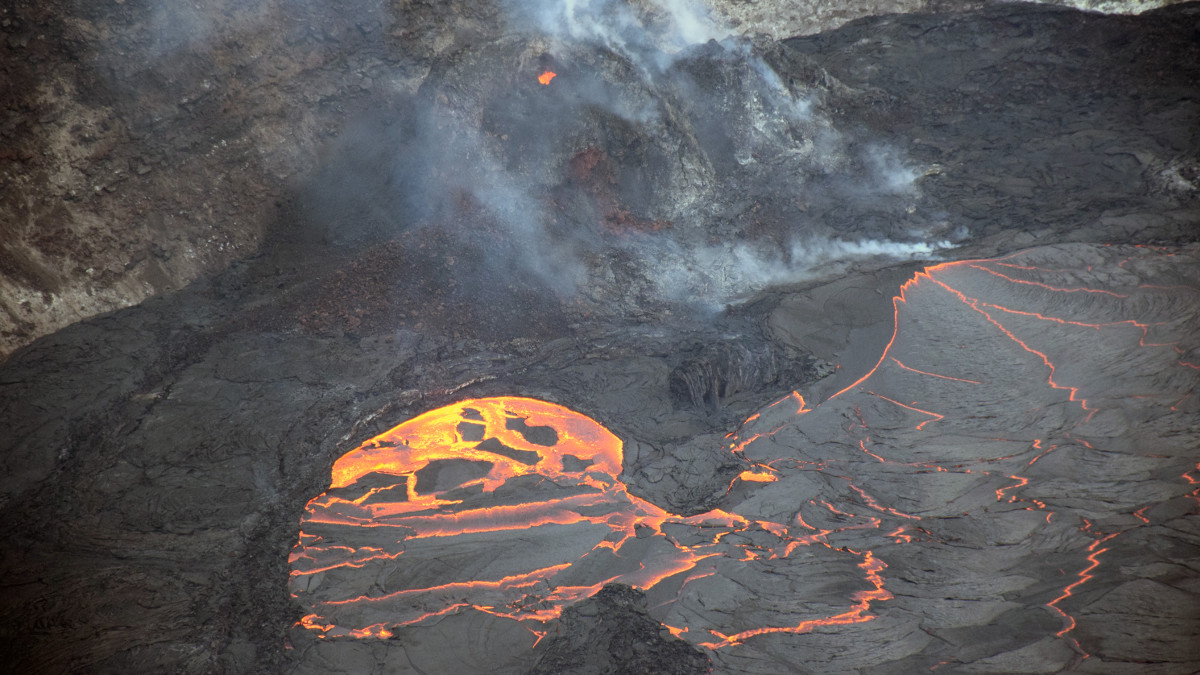
This map of Halema‘uma‘u at the summit of Kīlauea shows 20 m (66 ft) contour lines (dark gray) that mark locations of equal elevation above sea level (asl). The map shows that the lava lake has filled 225 m (738 ft) of the crater, to an elevation of 742 m (2434 ft) asl since the eruption began on December 20, 2020. Contour lines highlighted in green, purple, and blue mark the approximate rim of Halema‘uma‘u, the edge of the eastern down-dropped block, and the approximate rim of the 2018 collapse, respectively. Lava is expected to be within view of the Kīlauea Overlook visitor area shortly before it rises to the level of the green contour line at 800 m (2625 ft) asl. USGS map.
(BIVN) – The USGS Hawaiian Volcano Observatory on Thursday provided updates on Hawaiʻi island’s two active volcanoes.
USGS HVO posted this update for Kīlauea on April 8:
Activity Summary: Kīlauea Volcano is erupting. Lava activity is confined to Halemaʻumaʻu with lava erupting from a vent on the northwest side of the crater. This morning, April 8, the lava lake was 225 m (738 ft) deep and remains stagnant over its eastern half. SO2 emission rates remain elevated at 900 t/day, last measured on April 7.
Summit Observations: The most recent sulfur dioxide emission rate, measured on April 7, was 900 t/day. This is elevated compared to rates in the months before the eruption started on December 20 (less than 100 t/day), but lower than emission rates from the pre-2018 lava lake (around 5,000 t/day). Summit tiltmeters recorded minor change over the past 24 hours. Seismicity remains stable, with elevated tremor.
East Rift Zone Observations: No unusual activity noted in the region. Geodetic monitors indicate that the summit and upper East Rift Zone—between the summit and Puʻu ʻŌʻō—is refilling at rates similar to those measured over the past 2 years and before the December 2020 eruption. SO2 and H2S emissions from Puʻu ʻŌʻō were below instrumental detection levels when last measured on January 7.
Halemaʻumaʻu lava lake Observations: Lava effusion from the west vent continues to supply the lava lake within Halema‘uma‘u crater. The west vent is consistently effusing lava at a low rate through a crusted-over channel and submerged inlet to the lake. Lava circulation and intermittent foundering of crust continue in the western portion of the lava lake, with lava oozing out sporadically in areas along the perimeter of the lake. The total depth of the lake is 225 m (738 ft) this morning as measured by a continuous laser rangefinder on the active western portion of the lake. Stagnant and solidified lava crust covers the eastern portion of the lava lake and is slowly growing westward.
Near-real time webcam views of the lava lake can be found here.
Hazard Analysis: High levels of volcanic gas are the primary hazard of concern regarding the ongoing activity at Kīlauea’s summit, with additional hazards from crater wall instability and rockfalls. Large amounts of volcanic gas—primarily water vapor (H2O), carbon dioxide (CO2), and sulfur dioxide (SO2)—are continuously released during eruptions of Kīlauea Volcano. As SO2 is released from the summit, it will react in the atmosphere to create the visible haze known as vog (volcanic smog) that has been observed downwind of Kīlauea. Vog creates the potential for airborne health hazards to residents and visitors, damages agricultural crops and other plants, and affects livestock. The unstable nature of the crater rim is a hazard surrounding Halemaʻumaʻu crater, an area that has been closed to the public since early 2008. Pele’s hair and other lightweight volcanic glass fragments from the lava fountains within Halemaʻumaʻu will fall downwind of the fissure vents and lava lake, dusting the ground within a few hundred meters (yards) of the vent. Strong winds may waft lighter particles to greater distances. Residents should minimize exposure to these volcanic particles, which can cause skin and eye irritation similar to volcanic ash.
The Hawaiian Volcano Observatory also provided this weekly update on Mauna Loa:
Activity Summary: Mauna Loa Volcano is not erupting. Rates of deformation and seismicity at the summit remain slightly elevated and above long-term background levels. Other Mauna Loa monitoring data streams show no significant change in deformation rates or patterns that would indicate increased volcanic hazard at this time.
Observations:
During the past week, HVO seismometers recorded approximately 134 small-magnitude earthquakes below Mauna Loa, most concentrated below the summit and upper-elevation flanks of the volcano. All of the earthquakes were less than M2.5 and occurred mostly at depths of less than 8 km (about 5 mi) below ground level.
Global Positioning System (GPS) measurements have recently shown a change to contraction at the summit which is most likely due to deflation of the shallow summit reservoir.

USGS: Changes in distance between two GPS stations on opposite sides of MOKUAWEOAWEO, Mauna Loa’s summit caldera. Extension across the caldera is often an indication of inflation of the shallow summit magma reservoir.
Gas concentrations (0 ppm SO2) and fumarole temperatures (below 100 degrees Celsius or 212 degrees Fahrenheit) at both the summit and at Sulphur Cone on the Southwest Rift Zone remain stable.
Webcam views have shown no changes to the volcanic landscape on Mauna Loa over the past week.


by Big Island Video News7:32 am
on at
STORY SUMMARY
HAWAIʻI ISLAND - Kīlauea Volcano is erupting and is at an alert level of WATCH. Mauna Loa is not erupting, and remains at an alert level of ADVISORY.